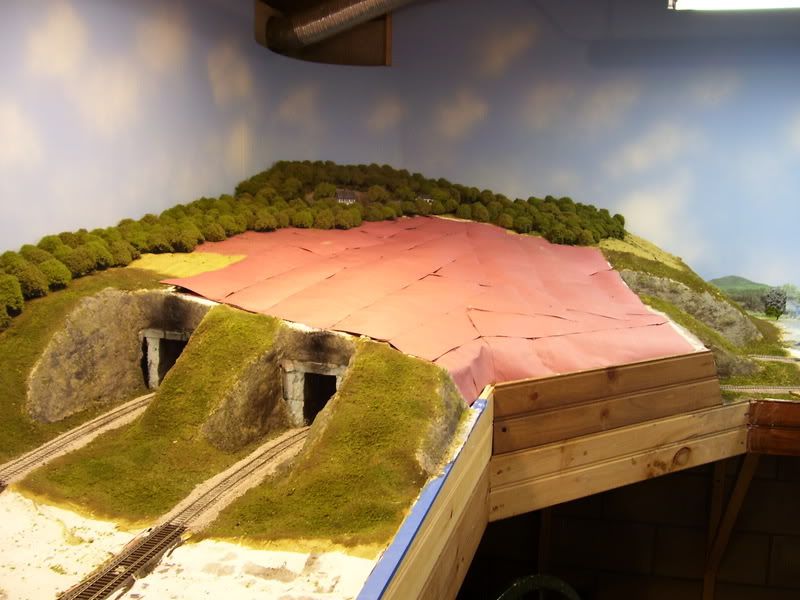Hi all, quick question. What are your preferances to cover spray foam to create retaining walls or mountains? I may just paint the mountains, but the walls need to be etched to stone or block.Thanks for any and all responses.
Jim
Hi all, quick question. What are your preferances to cover spray foam to create retaining walls or mountains? I may just paint the mountains, but the walls need to be etched to stone or block.Thanks for any and all responses.
Jim
I’ve used both joint compound and plaster. The joint compound has to be put on in thin layers and each layer has to dry before another layer is applied. If not it will crack! Plaster can be used almost anywhere and can be mixed to almost any consitency. I’ve mixed it so that it can be poured in almost like a thin slurry up to putting it on like a thick cream. I’ve had very few cracking issues with it.
I like plaster better than mud. It’s seems a little stronger. I’ve had problems with mud shrinking and cracking if it’s applied too thick. Takes longer to dry too.
My preference is dryer softener sheets dipped in cheap plaster O Paris. Adding a little bit of vinegar helps slow the curing process if it’s setting up too fast for you.
I cast my stone walls with Hydrocal and rubber molds. Hydrocal is specifically for casting, and picks up the fine detail very well. I then put each individual casting piece in place on the wall, trimming and cutting as necessary. If you wait about 10-12 minutes after pouring the Hydrocal into the mold, you can carefully shape it around a curve so that it will take the shape you want. The molds I have are typically 3 inches high, and about 6 to 8 inches long. Hydrocal takes paints and stains well, and an India Ink wash will really bring out the details.
I prefer sculptamold over both plaster and joint compound. You can put it on in layers an inch deep and it still dries without cracking, it is more controllable ,stays where you put, it than plaster. Has a better texture than plaster,yet can still be smoothed out for roads etc, with a moistened trowel. Makes a little softer base for trees etc,and is easier to carve than either plaster or joint compound. BILL
I agree it’s a great product, but not very good if you want to carve brick or stone shapes in it.
I prefer joint compound. It doesn’t require any mixing, just scoop it out of the pail and apply it. It stays workable for a long time and is easily carved as it starts to set. It does take a long time to completely set. I leave it alone for at least a day or two. I use an offset trowell like a cake icing pallette or an artist’s pallett to apply it. I’ve never had any problems with it shrinking and cracking, I guess because I’m aware of having to keep the coats fairly thin. I guess drywalling my basement walls taught me that. I use plaster for rock moulds though.
I use all three since each has its advantages and disadvantages. There’s no reason to limit ourselves to a single technique in any phase of this hobby. Sculptamold is by far the most workable, but the draw back is cost so I only use it for small landforms. Lately I’ve used it instead of rock molds to model rock faces and outcroppings. The somewhat lumpy text makes it ideal for creating realistic rock formations. Joint compound has a longer working time than plaster but as has been pointed out, it tends to crack and is not as strong as plaster. I use plaster of paris where I need strength, such as near the front of the layout where it might take some abuse. Plaster has the shortest working time of the three.
I posted this pic in WPF but am reposting it hear to show how I I used the various products.

The walls of the cuts leading to the tunnel are Sculptamold formations. I used joint compound to for the base layer for the walls and to give the Sculptamold something to grip. The hill itself started with a layer of red resin paper over cardboard webbing. This picture was take before applying the hard surface. I first put down a base layer of joint compound about 2/3 of the way back from the aisle. After it had set, I came back and added a layer of plaster of paris over the front third to give me extra strength. The back third I didn’t even bother with a solid surface. I just glued the polyfiber trees directly to the resin paper. You can’t see it and I don’t need any strength since that is all behind the track where no hands should ever go.
I used Joint Compound too thick, and it cracked (a lot). It’s also very, very heavy compared to plaster and lightweight Hydrocal. I had to add another leg just to support the weight.
I use powdered joint compound which comes in a bag and is mixed with water just like plaster. Its advantage is it has a much longer working time. It comes in various setting times and I use the 90 minute type. I can mix it thin or thick depending on the application. I find that two thin layers works better than one thick one and will result in less cracking. It isn’t as strong as plaster which is why I switch to plaster of paris for areas near the front of the benchwork.
I would opt for plaster of paris or Sculptamold. Both of these products lend themselves to carving. They also set up a lot faster.